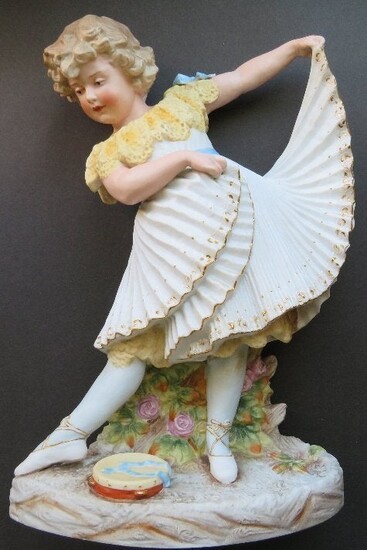Heubach Porcelain Ballet Dancer Girl Large Figure 1880
Large Victorian porcelain sculpture, 15 inches [38cm] tall, girl with a tambourine dancing Italian Tarantella. A fine specimen of the work by Gebruder Heubach, Thuringia, Germany, 1880s-1900s; unmarked. Precisely painted cute face of the girl with her plump cheeks, curls and blue eyes shows why later, in the 1910s, Heubach decided to produce porcelain doll heads.
According to the former owner, the figure was one of the decoration and presentation pieces in the fine porcelain store closed in the 1930s. The store was specialized on the European porcelain.
Brothers Georg Christoph and Philipp Jakob Heubach (Gebruder Heubach) bought a running porcelain factory in 1840 from Wilhelm Liebmann. The manufacture located in Lichte (Thuringia), Germany, was established in 1822 by Johann Heinrich Leder. According to his will, just two years later the factory was passed on to his cousins, Wilhelm and Heinrich Liebmann. The former acquired his brother's share in 1830 and thus became the sole owner.
In the middle of 19th century the wood for firing porcelain was more difficult to acquire in the area. So, the company started to produce smaller items than tableware. The factory under Heubach's management started to produce porcelain figurines. In 1876 the production of jewelry porcelain was started.
In 1846 his share took over Anton Heubach, a son of Christoph. In 1868, in turn, his share took Philipp's son, Louis Heubach. Anton Heubach left the company in 1876. Now that Louis Heubach was the sole owner, he brought in his three oldest sons Philipp, Hermann and Ottokar. Philipp and Ottokar Heubach took over the factory from their father in 1887.
In 1898, took place a comprehensive modernization of the company. At the World Exhibition in Paris in 1900, the company received the silver medal.
Philipp and Ottokar died in 1919 and Eduard Heubach, Hermann's son, who had been with the company since 1908, joined the board of directors.
In 1910 they started to make bisque doll heads as well as beer steins. The expanding firm bought in 1919 Porzellanfabrik Ernst Bohne und Söhne Rudolstadt.
In 1937 the company went bankrupt. It was saved by Otto Friedrich III, Prince of Ysenburg and Buedingen but in 1948 East Germany nationalized it. After the reunification of Germany in 1990, the factory returned to the estate of Ysenburg and Büdingen. In 1994 it was taken over by former employees.
Rates vary per zone/ country. We will adjust shipping costs with the invoice.
US: Priority (c 2-4 days) -------- $107.50
Canada: Priority (c 2-7 weeks) --- $124.50
World: Priority (c 2-8 weeks) ---- $212.50
Condition Report: The entire figure is c.15" tall [c.38cm]; c.11" x 6” [28cm x 15.2cm]; one end of the blue butterfly knot on the shoulder is missing, one chip on bottom edge of the base [see photos]; no other ships, no hairlines, very good condition.
View it on
Estimate
Time, Location
Auction House
Large Victorian porcelain sculpture, 15 inches [38cm] tall, girl with a tambourine dancing Italian Tarantella. A fine specimen of the work by Gebruder Heubach, Thuringia, Germany, 1880s-1900s; unmarked. Precisely painted cute face of the girl with her plump cheeks, curls and blue eyes shows why later, in the 1910s, Heubach decided to produce porcelain doll heads.
According to the former owner, the figure was one of the decoration and presentation pieces in the fine porcelain store closed in the 1930s. The store was specialized on the European porcelain.
Brothers Georg Christoph and Philipp Jakob Heubach (Gebruder Heubach) bought a running porcelain factory in 1840 from Wilhelm Liebmann. The manufacture located in Lichte (Thuringia), Germany, was established in 1822 by Johann Heinrich Leder. According to his will, just two years later the factory was passed on to his cousins, Wilhelm and Heinrich Liebmann. The former acquired his brother's share in 1830 and thus became the sole owner.
In the middle of 19th century the wood for firing porcelain was more difficult to acquire in the area. So, the company started to produce smaller items than tableware. The factory under Heubach's management started to produce porcelain figurines. In 1876 the production of jewelry porcelain was started.
In 1846 his share took over Anton Heubach, a son of Christoph. In 1868, in turn, his share took Philipp's son, Louis Heubach. Anton Heubach left the company in 1876. Now that Louis Heubach was the sole owner, he brought in his three oldest sons Philipp, Hermann and Ottokar. Philipp and Ottokar Heubach took over the factory from their father in 1887.
In 1898, took place a comprehensive modernization of the company. At the World Exhibition in Paris in 1900, the company received the silver medal.
Philipp and Ottokar died in 1919 and Eduard Heubach, Hermann's son, who had been with the company since 1908, joined the board of directors.
In 1910 they started to make bisque doll heads as well as beer steins. The expanding firm bought in 1919 Porzellanfabrik Ernst Bohne und Söhne Rudolstadt.
In 1937 the company went bankrupt. It was saved by Otto Friedrich III, Prince of Ysenburg and Buedingen but in 1948 East Germany nationalized it. After the reunification of Germany in 1990, the factory returned to the estate of Ysenburg and Büdingen. In 1994 it was taken over by former employees.
Rates vary per zone/ country. We will adjust shipping costs with the invoice.
US: Priority (c 2-4 days) -------- $107.50
Canada: Priority (c 2-7 weeks) --- $124.50
World: Priority (c 2-8 weeks) ---- $212.50
Condition Report: The entire figure is c.15" tall [c.38cm]; c.11" x 6” [28cm x 15.2cm]; one end of the blue butterfly knot on the shoulder is missing, one chip on bottom edge of the base [see photos]; no other ships, no hairlines, very good condition.



